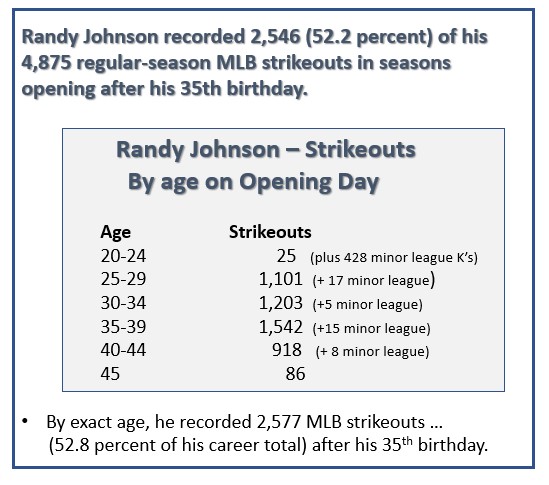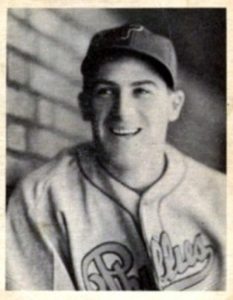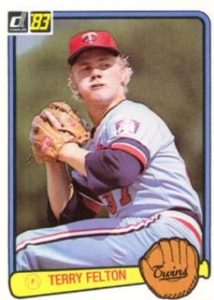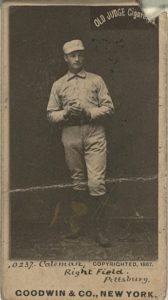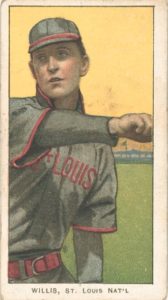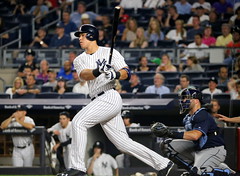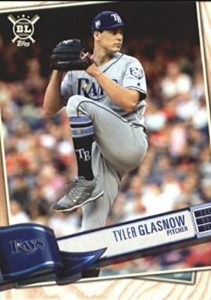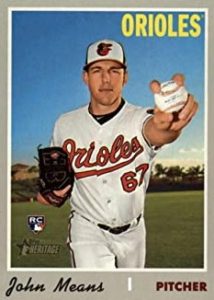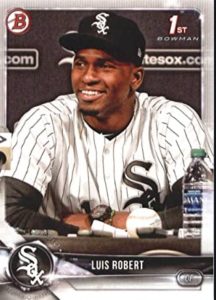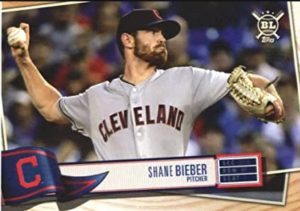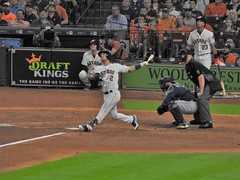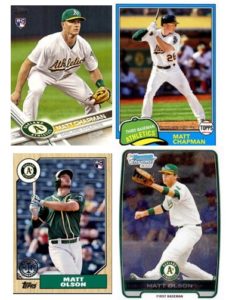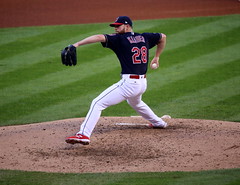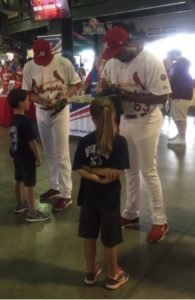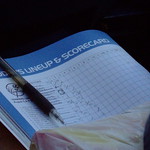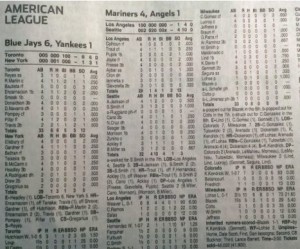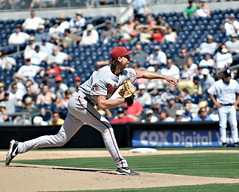
Photo by SD Dirk 
Six-foot-ten inch Randy Johnson stood tall, threw downhill and brought the heat. Drafted in the second round of the 1985 MLB draft (by the Montreal Expos) out of the University of Southern California, he pitched his way into the Hall of Fame during a 22-season major-league career that featured 303 victories (22nd all time) and 4,975 regular-season strikeouts (second only to Nolan Ryan). He was also ten-time time All Star and five-time Cy Young Award winner (second only to Roger Clemens’ seven).
Brett Carroll – One for the Ages.
Brett Carroll, a .201 career hitter (2007-12 … Marlins/Brewers/Nationals), faced Randy Johnson in just one game (June 8, 2009), but he will have a story to share long into the future. Johnson gave up three runs in five innings of a 4-0 Giants’ loss to the Marlins – and Carroll drove in all three tallies. He only batted twice against Johnson, hitting a three-run home run in the bottom of the second inning (Carroll’s first MLB long ball) and adding a triple in the fourth. Not bad. Two career at bats against Johnson – with two hits and seven total bases. I’d leave out the part about Johnson being 45-year-old and in his late MLB season at the time. Although The Big Unit did go 8-6, 4.88 with 86 strikeouts in 96 innings that season.)
In the post, we’ll take a look at a lineup of hitters who seemed to have Randy Johnson’s number. It’s part of a series inspired by Pedro Martinez.
Who’s Your Daddy? What It’s All About.
On September 24, 2004, in the middle of a tight pennant race, the Yankees handed future Hall of Famer Pedro Martinez and the Boston Red Sox a tough 6-4 loss. Martinez went 7 1/3 innings giving up nine hits and five earned runs. The game came just five days after (in his previous start) Martinez had lasted just five frames against the Bronx Bombers (eight hits, eight earned runs) in a 16-7 loss.
After that second loss, Martinez candidly commented, “What can I say? I just tip my hat and call the Yankees my daddy.” Little did he know that his comment – and a Yankee fans’ chant of “Who’s your daddy?” would follow him into future starts in New York (all the way to his final MLB start – against the Yankees for the Phillies – in Game Six of the 2009 World Series.)
The concept of “Who’s your daddy?” became the inspiration for Baseball Roundtable to take a look at the players who “had the number” of some of MLB’s premier pitchers.
Here are links to the previous editions of this series:
- Nolan Ryan, click here.
- Sandy Koufax, click here.
- Pedro Martinez, click here.
- Bob Gibson, click here.
BBRT Note: Keep in mind, the pitchers included in the “Who’s your daddy?” series are among the “best in the business.” They are selected not because of the players who performed well against them, but rather because solid hitter performance when they were on the mound was the exception rather than the rule.
Now, a look at the mound resume that earned Johnson a spot in this series – and then a lineup of players who seemed up to the task of facing Johnson’s downhill heat.
“Randy (Johnson) carries his emotions on his sleeve. So when Randy gets pumped, it’s pretty much wise to just go home. When he gets that look in his eyes, you know you’re not going tog get a hit off him. “
16-season major leaguer Mark Grace
During his career, Johnson won 20 or more games in three seasons, leading the NL with 24 victories (five losses) in 2002. He also led his league in strikeouts nine times; winning percentage, ERA and complete games four times each; shutouts and innings pitched twice. Like a fine wine, Johnson aged well. He fanned 300 or more batters in five seasons – four after turning age 35. Similarly, he earned the NL Cy Young Award in his age 35, 35, 37 and 38 seasons. ( In short, he was an intimidating and superbly effect presence on the mound.
But again, this post is not about the many batters Johnson dispatched to the dugout shaking their heads. It’s about a lineup of hitters who stood tall versus “The Big Unit.” As you go through this lineup, you’ll find some hitters you might have expected, like Albert Pujols and Chipper Jones at the corner infield spots, and some that may seem less likely, say Ty Wigginton at second base.
–—The Randy Jones “Who’s Your Daddy?” Lineup—
Regular-season stats – 10 at bat versus Johnson minimum.
Catcher – Paul Lo Duca … RHH, 5’10”, 193 lbs. (Twenty career hits versus Johnson)
Nobody had more regular-season hits in his career against Johnson than Paul Lo Duca (20 hits in 21 games and 63 at bats (.317 average). Not only that, his 14 RBI are second only to Manny Ramirez’ 17 against the big southpaw. To top it off, Lo Duca had a pretty good strikeout-to-walk ratio versus Johnson – five walks and six whiffs.
Lo Duca is one of those players whom BBRT thinks doesn’t get enough attention. In an 11-season MLB career (1998-2008 … Dodgers/Marlins/Mets/Nationals), the four-time All Star hit .286, with 80 home runs and 481 RBI. His best season was 2001, when he went .320-25-90 for the Dodgers.
I also consider Ivan Rodriguez for this spot. I-Rod had 21 hits against Johnson. Those 21 safeties were the most of any batter against Johnson, but two of them came in the post-season. In the regular-season, he hit .244 (19-for-78) with one home run and five RBI against Johnson. Lo Duca clearly deserves this spot.
There’s Statistics and then there’s ….
In 2003, Paul Lo Duca led MLB in runners thrown out stealing (but he also allowed the second most stolen bases). In 2004, he reversed those – allowing the most stolen bases (but throwing out the second most baser runners.) Al in all, it looks like Lo Duca was consistently tested.
——————————————————–
First Base – Albert Pujols … RHH, 6’3″, 235 lbs. (13 RBI in xx games versus Johnson)
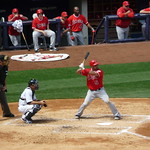
Photo by Marianne O’Leary 
Albert Pujols hit a healthy .458 (in 24 regular-season games) against Randy Johnson. He was 11-for-24 and eight of those 11 hits went for extra bases (three doubles and five home runs). He also had 13 RBI versus Johnson. So, despite have the 196th most plate appearances versus the HOF southpaw, Pujols was number-two in home runs and number-three in RBI against him (regular season). In Pujols’ final game against Johnson (June 30, 2009), in fact in his final two at bats against him, the 1B/OF hit a pair of home runs.
Pujols, still active, is a sure Hall of Famer. In 10 seasons (2001-19 … Cardinals/Angels), he has collected 3,202 hits (.300 average), 656 home runs and 2,075 RBI. He is a 10-time All Star, three-time league Most Valuable Player and was the 2001 NL Rookie of the Year.
Jack of All Trades
In 2002, Alert Pujols took the field defensively at 1B, 3B, SS, LF and RF.
Pujols has led his league in runs scored five times, home runs twice and hits, doubles, RBI and batting average once each. He has hit 30 or more home runs in 14 season, topped 100 RBI in 14 seasons and hit .300 or better in 11 campaigns. He is also .323-19-54 in 77 post-season games.
Consistency is Not a Hobgoblin
Albert Pujols, famously, topped .300, 30 home runs and 100 RBI in each of his first ten MLB seasons. He came close in his 11th campaign, .299-37-99.
——————————————-
Second Base – Ty Wigginton … (.393 average versus Johnson)
Ty Wigginton hit .393 and popped four long balls in xx games against Randy Johnson – all this after going zero-for-four in his first game against him (August 5, 2002). Wigginton’s success against the HOFer is a bit of a surprise, since Wigginton was a .261 career hitter over 12 seasons (2002-2013 … Mets/Pirates/Devil Rays/Astros/Orioles/Rockies/Phillies/Cardinals). Still, he had his moments – topping 20 home runs in four campaigns and making the AL All Star squad, as an Oriole, in 2010.
Where’s Waldo?
Ty Wigginton was a true journey man. In 12 MLB seasons, he suited up for eight different MLB teams – and started games at 1B,2B, 3B, LF RF and DH,
In nine games against Randy Johnson, Wigginton started for four different teams (Astros, Devil Rays, Pirates, Mets) and at four different positions (1B, 2B, 3B, LF).
Wigginton’s career line is .261-169-594.
———————————————————-
Third Base – Chipper Jones … SH, 6’4″, 210 lbs. (Six regular-season home runs, the most of any batter versus Johnson)
In 12 games against Johnson, Hall of Famer Chipper Jones hit .361, with six home runs and eight RBI. Those six home runs are the most by any batter against Johnson and the second-most Jones had against any pitcher. (He had seven career, regular-season long balls off Steve Trachsel, but in more than twice as many games (29 versus Trachsel and 12 versus Johnson). Jones did the most damage in 2000, when he faced Jones six times in two games and went four-for-six, with three home runs and five RBI. That season, Johnson was 19-7, 2.64, with 347 strikeouts in 248 2/3 innings – capturing his third Cy Young Award.
Bad Bookends
If you looked at his first and last games against Randy Johnson, you would not expect Chipper Jones to have put up good numbers against the big southpaw. The first time he faced Johnson (September 2, 1998), Jones, went zero-for-four, with a ground out and three swinging strikeouts. The final game in which he faced Johnson (May 27, 2009), Chipper went zero-for-three, with all three appearance ending in a strikeout (two swinging, one looking). So, for those book-ending games, Jones was zero-for-seven with six whiffs.
I did look consider a couple of other third baseman for this spot. Mike Blowers, who hit .563 against Johnson in six games (nine-for-sixteen) and Phil Nevin, who drove in the third-most runs against Johnson (13 in 24 games). Blowers’ line against Johnson was .563-0-7, while Nevin was .261-3-13. Jones got the edge for combing average and power.
Jones enjoyed a 19-season career (1993, 1995-2012 … Braves) – hitting .303, with 468 home runs and 1,623 RBI. He was an eight-time All Star and the 1999 National League MVP. He also won the 2008 NL batting title. While he never led his league in home runs, Jones hit 30 or more in six seasons and 20 or more in 14 campaigns. He had 100 or more RBI in nine seasons – eight consecutive (1996-2003). He stole 150 bases in his career, with a high of 25 in 1999.
Trivia that is Not so Trivial
Chipper Jones had more walks (1,512) than whiffs (1,409) in his career.
Only Mickey Mantle (536) and Eddie Murray (504) have more home runs among switch hitters than Chipper Jones (468).
Only Eddie Murray has more RBI (1,917) among switch hitters than Chipper Jones (1,623).
Chipper Jones is one of only two switch hitters with at least 5,000 plate appearances to hit .300 or better from both sides of the plate. Jones hit .303 left-handed and .304 right-handed. The other, by the way, is Hall of Famer Frankie Frisch, who hit .319 lefty and.308 righty over a 19-season MLB career (1919-37).
Chipper Jones is one of only two Braves with a career on- base percentage (with the Braves) over .400. Jones OBP was .401. By comparison, Hank Aaron’s OBP in 21-seasons with the Braves was .377. Billy Hamilton, who played with Braves (Beaneaters) franchise from 1896-1901 had the highest OBP for the team (.456). In a 14-season MLB career – from 1888-1901 – Hamilton .344, with a .455 OBP.
—————————————————
Shortstop – Miguel Tejada … RHH, 5’9″, 220 lbs. (Hit .386 versus Johnson)
In 16 games against Johnson, Miguel Tejada hit .386, with two home runs and eight RBI. In addition, he had a 1-1 strikeouts-to-walks ratio (five walks/five whiffs). I should note this was a very close call. I also considered Randy Velarde and Rich Aurilia for this spot. Velarde faced off against Johnson in 13 career regular-season games and hit .452 (19-for-42). His 19 hits tied for the second-most regular-season safeties against Johnson. Velarde, however, had no home runs, seven RBI (one fewer than Tejada) and walked four times, while fanning ten. Aurilia took the field (and batter’s box) against Johnson in 18 games and hit .333 (18-for-59), with three home runs and six RBI. He walked five times against The Big Unit and fanned 16. Anyone of these three would have fit in here. I subjectively gave Tejada a slight edge for putting the ball in play.
Tejada played 16 MLB seasons (1997-2011, 2013 … A’s/Orioles/Astros/Padres/Giants/Royals). He hit .285, with 307 home runs and 1,302 RBI. He was a six-time All Star and the 2002 American League MVP (.308-34-131 for the A’s). Tejada hit 30 or more home runs in four seasons, drove in 100+ tallies in six seasons and hit .300+ in five. Miguel Tejada is one of only 25 MLB players to drive in at 150 or more runs in a season. (In 2004, he went .311-34-150 for the Orioles.)
We May not Know where Waldo is, but We Do Know where Miguel is – on the Field
Between June 2, 2000 and June 21, 2007 – a seven-year span – Miguel Tejada did not miss a game. His 1,152 consecutive games played is MLB’s fifth-longest streak.
——————————————————
Outfield – Barry Bonds … LHH, 6’1″, 185 lbs. – or so it says in Baseball-Reference.com. (Walked once every 5.6 plate appearance versus Randy Johnson)
Barry Bonds faced off against Randy Johnson 62 times in 19 games – and put up a .306 average, with three home runs and 12 RBI. Just as important, he walked 11 times and struck out just six (and was HBP twice) – for a .452 on-base percentage.
Putting the ball in play.
In 2004, Barry Bonds faced Randy Johnson 15 times and did not strikeout once (three hits, two walks, two HBP).
Barry Bonds played 22 MLB seasons (1986-2007 … Pirates/Giants). He was a 14-time All Star, eight-time Gold Glover and seven-time MVP. He led the NL in home runs twice (an MLB record 73 in 2001); batting average twice; ruins scored once; RBI once; and walks 12 times. He finished his career with a .298-762-2,558 line and holds the career and single-season home runs records, as well as the career RBI record. In addition, his career 2,558 walks and 688 intentional walks are MLB highs. (He led his league in intentional walks 12 times – with a high of, and MLB-record, 120 in 2004. There is, of course, that “elephant in the room.”
______________________________________________________________
Not a Lot of Action
Rickey Henderson struck more often against Randy Johnson than any other batter – 30 times in 85 plate appearances/59 at bats. He also walked more times against Johnson than any other batter (26 times). When he did make contact, Henderson hit .119 (7-for-59) against him).
_______________________________________________________________
Outfield – Moises Alou … RHH, 6’3″, 185 lbs. (.571 batting average against Johnson)
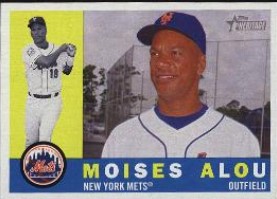 Moises Alou’s .571 average (8-for-14) against Randy Johnson is the highest of any hitter with at least 10 at bats against the HOF lefty, He did most of his damage during the 2000 season, when he played two games against Johnson and went three-for-five, with a walk, home run and four RBI. In his five career games against Johnson, he was never held hitless.
Moises Alou’s .571 average (8-for-14) against Randy Johnson is the highest of any hitter with at least 10 at bats against the HOF lefty, He did most of his damage during the 2000 season, when he played two games against Johnson and went three-for-five, with a walk, home run and four RBI. In his five career games against Johnson, he was never held hitless.
Alou played in 17 MLB seasons (1990, 1992-98, 2000-2008 …. Pirates/Expos/Marlins/Astros/Cubs/Giants/Mets). He was a six-time All Star, whose best season was probably 1998, when he went .312-38-124 for the Astros. Alou put up a .303 career average, with 332 home runs and 1,287 RBI. He hit 30 or more home runs three times and drove in 100+ runs in five seasons.
_________________________________________________________
Shout out to Mel Hall and Bill Pecota
Mel Hall had the most plate appearances and at bats against Randy Johnson without striking out (18 plate appearances/16 at bats). He did, however, have just three singles and two walks (.188) average. Second in both plate appearances and at bats versus Johnson without a whiff was Bill Pecota (16/11). Pecota had four hits and two walks (.364).
Hall, an outfielder, put up a .276-134-620 line in 13 MLB seasons, while Pecota (infielder) hit .249-22-148 in nine MLB seasons.
____________________________________________________________
Outfield – Manny Ramirez … RHH, 6′, 225 lbs. (17 RBI in 20 regular season games versus Randy Johnson)
No hitter drove in more regular season runs versus Randy Jonson than Manny Ramirez, who drove in 17 tallies in 20 games. His five regular-season home runs off the Big Unit is tied for second among all hitters. Overall Manny went 14-for-50 versus Johnson, with nine of those 14 safeties going for extra bases.
How About a Mulligan for 1995?
In 1995, Manny Ramirez faced Randy Johnson in just one regular-season game – going zero-for-four with two strikeouts. They matched up again in the AL Championship Series (Ramirez’ Indians versus Johnson’s Mariners) and Ramirez recorded six plate appearance against Johnson – going 0-for-6 with tree whiffs.
Manny Ramirez had a 190-season MLB career (1993-2011 … Indians, Red Sox, Dodgers, Rays, White Sox). He hit .312, with 555 home runs and 1,831 RBI. He was a 12-tie All Star and the 2002 AL Batting champ. He also led his league in home runs and RBI once each. Ramirez hit 30+ home runs in 12 seasons, drove om 100+ runs in 12 seasons and hit .300+ in 11 full campaigns. He also hit .285-29-78 in 111 post-season games – and was the 2004 World Series MVP.
Other outfielders, I took a long hard look at: Alex Rios (.500 average … 7-for-14) versus Johnson; Carlos Beltran (.409-1-8 in eight games versus Johnson); and Ellis Burks (.281-3-13 in 12 games);
___________________________________________________________
Not Again!
Jason LaRue had a tough time against Randy Johnson. He struck out the first seven times he faced him – getting to two-ball count only once. He tightened up after that going ground out, fly out, sacrifice in his final three plate appearance versus Johnson. LaRue, by the way, hit .231 over a 12-season MLB career (922 games)
______________________________________________________
Pitcher – Seth McClung … LHH/RHP, 6’6″, 280 lbs. (Johnson never got him out)
Seth McClung only found himself matched up against Randy Johnson in one contest, it came on June 3 2008 and McClung got the win, pitching six innings of one-run ball in a 7-1 Brewers ‘win over the Diamondbacks. At the plate, McClung wen 2-for-2 versus Johnson (both singles).
BIG Time Match up
When Brewer Seth McClung started against Randy Johnson and the Diamondbacks, it was a BIG mound confrontation. The two pitchers stood a combined 13′ 4″ tall and weighed a combined 505 lbs.
 McClung’s career mound record (2003, 2005-09 … Devil Rays/Brewers) was 26-34, 5.46.) At the plate he was five for 27 (.185).
McClung’s career mound record (2003, 2005-09 … Devil Rays/Brewers) was 26-34, 5.46.) At the plate he was five for 27 (.185).
O-Fer Pete’s Sake
When it comes to pitcher futility (in the batter’s box) versus Johnson, we might look to Tom Glavine who had 14 regular-seasons career at bats (17 plate appearances) versus Johnson and fanned ten times. He did draw a pair of walks and put down one successful sacrifice. For his career, Glavine had a regular-season average of .186 (246-for-1,323).
Primary Resource: Baseball-Reference.com
 Baseball Roundtable is on the Feedspot list of the Top 100 Baseball Blogs. To see the full list, click here.
Baseball Roundtable is on the Feedspot list of the Top 100 Baseball Blogs. To see the full list, click here.
I tweet (on X) baseball @DavidBaseballRT
Follow/Like Baseball Roundtable’s Facebook Page here. More baseball commentary; blog post notifications; PRIZES.
Member: Society for American Baseball Research (SABR); The Baseball Reliquary; The Negro Leagues Baseball Museum.
